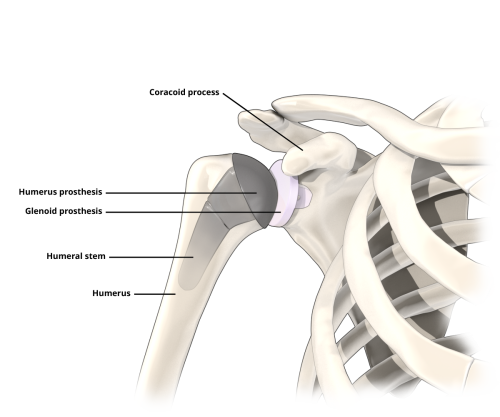close search

The surgical intervention and the use of a shoulder prosthesis is designed to restore shoulder mobility in patients with severe osteoarthritis of the shoulder joint, as well as to repair damage caused by external influences, such as an accident.
A shoulder prosthesis is necessary when the joint surfaces are irreparably damaged, conservative methods have failed to alleviate the pain, the shoulder joint no longer functions properly, and the resulting pain can no longer be treated.
Surgical intervention is necessary for the insertion of the shoulder prosthesis.

There are two types of shoulder prostheses that are used for the shoulder joint.

The anatomical prosthesis simulates the natural anatomy of the shoulder joint. The humeral head is replaced with a metal head of the same size. This is anchored into the bone via a shaft. The artificial acetabular cup is made from a specific type of polyethylene. This combination can fully restore the mobility of the shoulder joint. It enables the patient to do sports again. Some golfers even report an improved tee shot after using the shoulder prosthesis! For the anatomical prosthesis to function properly, proper functioning of the rotator cuff is essential.

The inverted prosthesis does not simulate the anatomy of the shoulder joint, but rather its function. The components of the prosthesis are reversed (inverted), i.e. arranged the opposite way round to the natural shoulder joint.
A major advantage of this prosthesis is that it works even in badly damaged or worn shoulder joints. The prosthesis works almost as well as the original shoulder joint, but the range of motion is slightly reduced, especially when moving the arms overhead or behind the back.
The shoulder surgery is a highly standardised procedure. Good preoperative planning is essential, as it defines the various bone cuts and determines the sizes of implant to be used. This planning data is continuously checked and confirmed during the operation.
The procedure is gentle on the joints at the front of the shoulder, as there are no nerves running between certain muscular levels.
The important axillary nerve is identified in order to protect it. Adhesions and scarring of the osteoarthritis of the shoulder joint are removed and the joint is exposed.
The first incision is made at the humeral head. The head of the humerus is detached and the bed for the prosthesis is prepared. Only the remaining cartilage is removed from the joint socket and, depending on the type of prosthesis, a new socket or a ball is inserted. Finally, the corresponding counterpart is pressed into the head of the humerus in such a way that it does not have to be fixed with cement. The function of the joint is tested using trial components. Only once the whole joint is working smoothly is the permanent implant inserted.
The patient is required to stay in the clinic after for up to twelve days after the operation. Physiotherapy and mobilisation of the shoulder joint begin the first day after the operation. This promotes coordination and mobility and helps to build muscle. The physiotherapy is passive, meaning that the physiotherapist guides the movement. In addition, the shoulder joint is moved using a device known as a motor rail.
The rehabilitation measures are carried out on an inpatient basis after the operation and last up to four weeks.
For the first six weeks after the procedure, the arm must not be put under any strain and movement should kept to a minimum. After this rest period, the shoulder joint prosthesis is exposed to all levels of movement and exertion. After about three months, the shoulder joint should be functioning so well that the patient can resume carrying loads of up to five kilograms without pain.
No. There is a wide variety of different implants available, and the prostheses are manufactured in components that can be combined. This means that the patient’s individual anatomy can always be simulated so well that a suitable, functioning prosthesis is implanted in every case.
Before a prosthesis is implanted, the bone anatomy of the shoulder is precisely mapped using a three-dimensional reconstruction of the CT scan, and the individual prosthesis components are meticulously tested until the right combination is found. This approach guarantees the best possible outcome every time.
The shoulder prosthesis operation usually takes about two hours. The duration of the operation depends on the specific circumstances encountered during surgery. However, in the vast majority of cases, the procedure is well standardised and proceeds without complications. Patients tend to recover very quickly from the surgery, as shoulder operations are not very stressful for the whole body.
After just one or two days, you can use your arm again for light tasks. You will usually stay in hospital for about five days, depending on how quickly you recover and how severe the pain is. The operation is not very painful, but a pain catheter is often administered to promote rapid mobility after surgery.
All recent studies show that 90 percent of prosthetic shoulders last for at least ten years. The main limiting factor is the anchoring of the acetabulum in the anatomical prostheses, which is susceptible to loosing over time. In addition, with certain prostheses, the bones around the implant may recede. In most cases, however, this has no impact on the longevity of the prosthesis.